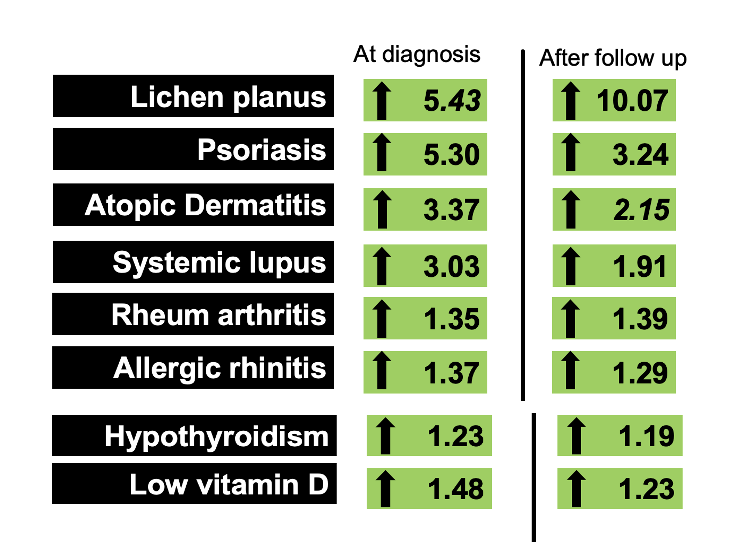Disease Associations in Korean Patients with LPP
Patients with LPP are At Risk for Several Diseases
Several studies to date have set out to examine whether patients with LPP are at increased risk for developing certain diseases. In 2022, we reviewed one such interesting study by Joshi et al. A link to this study is provided below.
Authors for Korea performed a retrospective population-based study using data from the National Health Insurance Service Database of Korea from 2002 to 2019. Inclusion criteria included patients aged ≥18 years with 3 or more documented medical visits for LPP. The data (adjusted hazard ratios for incident disease outcomes and mortality) were compared with 1:20 with age-, sex-, insurance type-, and income level-matched controls.
Reuslts
There were 2026 patients with LPP that were matched to 40,520 controls.
Diseases Present at the Time of Diagnosis
Several autoimmune diseases were found to be increased in patients at the time of being diagnosed with LPP. There was a 3.03 fold increased risk of lupus, 5.30 fold increased risk of psoriasis, 1.35 fold increased risk of rheumatoid arthritis, 1.98 fold increased risk of ulcerative colitis, 5.43 fold increased risk of lichen planus, 3.37 fold increased risk of atopic dermatitis, 1.37 fold increased risk of allergic rhinitis, 1.16 fold increased risk of diabetes, 1.23 fold increased risk of hypothyroidism, 1.11 fold increased risk of hypertension, 1.19 fold increased risk of dyslipidemia, 1.16 fold increased risk of a mood disorder, 1.48 fold increased risk of vitamin D deficiency and 1.16 fold increased risk of iron deficiency
Diseases Developing During Follow up
Authors also examined the incidence and risks of comorbidities during follow-up after LPP diagnosis.
There was a 10.07 fold increased risk of lichen planus, 3.24 fold increased risk of psoriasis, 2.15 fold increased risk of atopic dermatitis,1.91 fold increased risk of systemic lupus, 1.42 fold increased risk of hyperthyroidism, 1.39 fold increased risk of rheumatoid arthritis, 1.29 fold increased risk of allergic rhinitis, and 1.19 fold increased risk of hypothyroidism a 2.33 fold increased risk of non-melanoma skin cancer and 1.23 fold increased risk of having low vitamin D levels. After adjusting for comorbidities (ie. the Charlson comorbidity index) there was no difference in mortality.
Conclusion
This study is interesting a supports the view that patients with LPP are at increased risk to develop several autoimmune diseases, hypothyroidism and possibly skin cancer. Cardiovascular risk factors including hypertension, dyslipidemia, diabetes were more common in patients with LPP at the time of diagnosis.
REFERENCES
Lim SH Prevalence and Incidence of Comorbid Diseases and Mortality Risk Associated with Lichen Planopilaris: A Korean Nationwide Population-Based Study. Clin Exp Dermatol. 2023 Jul 11;llad235
Joshi et al. Comorbidities associated with lichen planopilaris: a case-control study using the All of Us database. Int J Dermatol. 2022 Oct 2.
Nasimi M et al. Comorbidities in Patients with Lichen Planopilaris: A Case-Control Study. Skin Appendage Disord. 2022 Jul;8(4):302-306.
Conic et al. Exploring the association between lichen planopilaris, cardiovascular and metabolic disorders. J Eur Acad Dermatol Venereol 2021 Nov;35(11):e826-e828.
This article was written by Dr. Jeff Donovan, a Canadian and US board certified dermatologist specializing exclusively in hair loss.



